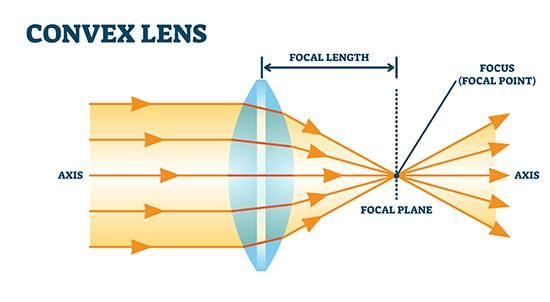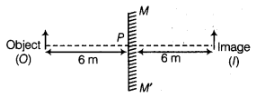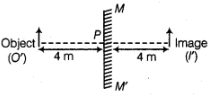Class 7 Science Chapter 13 HOTS Questions - Light
Q1: How will you identify the three mirrors, i.e., convex, concave and plane mirror without touching them?
Ans: We can identify the mirrors by seeing the image formed by them.
- Plane mirror: The image is always virtual, erect, and the same size as the object.
- Convex mirror: The image is erect, virtual, and smaller than the object.
- Concave mirror: The image can be real and inverted, or virtual and magnified, depending on the object's distance from the mirror.
Q2: How can you obtain a real image of a distant object?
Ans: By using concave mirror or convex lens and a screen we can obtain a real image of a distant object. Q3: The concave reflecting surface of a torch got rusted. What effect would this have on the beam of light from the torch?
Q3: The concave reflecting surface of a torch got rusted. What effect would this have on the beam of light from the torch?
Ans: The beam of light will be of lower intensity due to diffused or irregular reflection.
Q4: If the side mirror of a scooter is replaced by a plane mirror, will it cause any inconvenience to the driver?
Ans: Yes, it will cause inconvenience to the driver and he will not be able to see the traffic behind him properly.
Q5: Rajesh for observing dispersion of light, used light from laser torch to fall on a prism. Will he be able to observe a band of seven colours?
Ans: No, because laser torch gives out light of only one colour.
Q6: Mention the name of lens whioh can converge the sun’s rays to a point and burn a hole in the piece of paper.
Ans: Convex lens is a lens which can converge the sun’s rays to a point and burn a hole in the piece of paper.
Q7: The distance between an object and a convex lens is changing. It is noticed that the size of the image formed o a screen is decreasing. Is the object moving in a direction towards the lens or away from it?
Ans: In case of convex lens, when we move the object far away from the lens, the size of image decreases and ultimately, when object is at infinity, it will form a point image at focus.
Q8: Two different types of lenses are placed on a sheet of newspaper. How will you identify them without touching?
Ans: On identifying the letters of newspaper, we can differentiate the two types of lenses.
If image is large or magnified, then the lens is a convex lens and if the image is smaller or diminished in size for all the positions of object, then the lens is concave.
Q9: The side mirror of a scooter got broken. The mechanic replaced it with a plane mirror. Mention any inconvenience that the driver of the scooter will face while using it.
Ans: As we know that the side mirror of a scooter must be of convex mirror so that we can view a wide range of traffic spread over a large area. But if plane mirror is used, we are not able to see large area of traffic which may be difficult for driving vehicle and can cause accident.
Q10: A shopkeeper wanted to fix a mirror which will give a maximum view of his shop. What type of mirror should he use? Give reason.
Ans: If a shopkeeper wanted to fix a mirror which will give him maximum view of his shop, he should use convex mirror. In case of convex mirror, it will give a wider field of view, i.e. it can collect light from a large area spread over them.
Q11: Boojho made light from a laser torch to fall on a prism. Will he be able to observe a band of seven colours? Explain with a reason.
Ans: No, he will not observe band of seven colours because laser light consists of monochromatic light of single colour. But seven colours of bands are only observed, when a white light is passed through a prism and dispersion takes place.
Q12: Briefly explain why in an ambulance words are written laterally inverted.
Ans: The word AMBULANCE is written in reverse on the front of the vehicle for a practical reason:
- When drivers look in their rear view mirrors, they see the word correctly.
- This helps them identify the ambulance quickly and give way.
- It is important for ambulances to reach hospitals without delay, as they are responding to emergencies.
Q13: Assume, a person is standing in front of a plane mirror. The distance between the mirror and his image is 6 m. If the person moves 2 m towards the plane mirror, what would be the distance between the person and his image?
Ans:
Since, the image is 6m away from the plane mirror. So, it means that the object is also 6m away from the mirror.
[Because OP = PI]
So, when the person moves 2 m towards the plane mirror, then the distance between the person and the plane mirror will be equal to (6 m – 2 m) = 4 m, this means that distance between the image and the mirror will be 4m.
 The distance between the person and his image = PO’+ PI’= 4 + 4 = 8m
The distance between the person and his image = PO’+ PI’= 4 + 4 = 8m
Q14: It was observed that when the distance between an object and a lens decreases, the size of the image increases. What is the nature of this lens? If you keep on decreasing the distance between the object and the lens, will you still able to obtain the image on the screen? Explain.
Ans: The lens in question is a convex lens. When the distance between an object and a convex lens decreases, the size of the image increases. This is because a convex lens converges light rays, creating a larger image as the object gets closer. As you continue to decrease the distance between the object and the lens:
- The image will initially remain clear and magnified.
- Eventually, the image may become virtual, meaning it cannot be projected onto a screen.
- At very close distances, the image may appear distorted or blurred.
Q15. You are given three mirrors of different types. How will you identify each one of them?
Ans: We can identify the mirrors by observing the images they create:
- Plane Mirror: Produces an image that is erect, the same size as the object, and located at the same distance behind the mirror as the object is in front.
- Concave Mirror: Can create a real and inverted image when the object is placed far away. When the object is close, it forms a virtual, erect, and magnified image.
- Convex Mirror: Always produces an erect, virtual image that is smaller than the object.
Q16: Boojho and Paheli were given one mirror each by their teacher. Boojho found his image to be erect and of the same size, whereas Paheli found her image erect and smaller in size. This means that the mirrors of Boojho and Paheli respectively are
a) plane mirror and concave mirror
b) concave mirror and convex mirror
c) plane mirror and convex mirror
d) convex mirror and plane mirror
Ans: c) plane mirror and convex mirror
Boojho's mirror is a plane mirror since it produces an erect image of the same size. Paheli's mirror is a convex mirror, which gives an erect but smaller image.
Q17: If an object is placed at a distance of 0.5 m in front of a plane mirror, the distance between the object and the image formed by the mirror will be
a) 2 m
b) 1 m
c) 0.5 m
d) 0.25 m
Ans: b) 1 m
The image distance is equal to the object distance in a plane mirror. Thus, the total distance is 0.5 m + 0.5 m = 1 m.
Q18: A rainbow can be seen in the sky
a) when the sun is in front of you
b) when the sun is behind you
c) when the sun is overhead
d) only at the time of sunrise
Ans: b) when the sun is behind you
A rainbow forms when sunlight is refracted and reflected in raindrops, appearing when the sun is behind the observer.
Q19: You are provided with a convex mirror, a concave mirror, a convex lens and a concave lens. You can get an inverted image from
a) both concave lens and convex lens
b) both concave mirror and convex mirror
c) both concave mirror and convex lens
d) both convex mirror and concave lens
Ans: c) both concave mirror and convex lens
An inverted image can be formed by a concave mirror and a convex lens when the object is placed within the appropriate distance.
Q20: An image formed by a lens is erect. Such an image could be formed by
a) convex lens provided the image is smaller than object
b) concave lens provided the image is smaller than object
c) concave lens provided the image is larger than object
d) concave lens provided the image is of the same size
Ans: b) concave lens provided the image is smaller than object
A concave lens always produces an erect and smaller image when the object is placed at any distance.
|
111 videos|286 docs|28 tests
|
FAQs on Class 7 Science Chapter 13 HOTS Questions - Light
| 1. What is the meaning of HOTS in education? |  |
| 2. How can teachers incorporate HOTS in their classroom? |  |
| 3. Why is it important to develop HOTS in students? |  |
| 4. What are some examples of HOTS activities? |  |
| 5. How can parents support the development of HOTS in their children? |  |

















